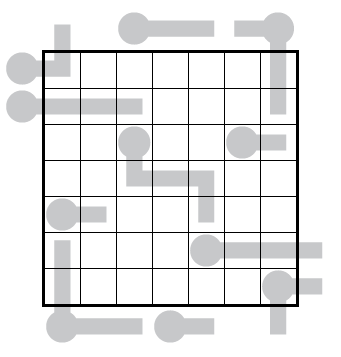Championship Chatter – High Rising Temperatures
The hardest puzzle I wrote for the USPC was originally intended to be presented as a subtle “surprise”. The rules would have covered what thermometer shapes do (strictly increase from bulb to flat end), but would not have been explicit that those shapes could reach outside the grid. So finding a grid with no external numbers but with many external shapes would have been a manageable but perhaps unexpected surprise. But it was decided to just be explicit here, and with some other authors in the last few months having used the same external clue ideas with skyscrapers (including myself here with an Even/Odd Skyscrapers after I knew the fate of this puzzle) it’s not clear if this would have been unexpected anyway.
I thought this was an interesting extension of some inequality skyscraper concepts I’ve seen elsewhere. My first attempt at this puzzle type was judged very elegant and far too hard. My second attempt kept one of these two traits and made it onto the test. Like the TomTom, this variation seemed to get pretty good reviews, but I do know some solvers who fell into the trap of thinking an outside number blocked that number from appearing inside the grid.

or solve online (using our beta test of Penpa-Edit tools)
Theme: No given numbers, and full clue cell symmetry
Rules: Standard Skyscrapers rules. Also, as in Thermo-Sudoku, digits must be strictly increasing in all thermometer shapes from round bulb to flat end.
Answer String: For the USPC, the answer string was the internal cells in the 4th row and 7th row. For this week, you can just hit the solved button on an honor system if you think you’ve solved it.
Solution: PDF

Solved this one the day after the contest was over, and it was pretty hard indeed. Good thing I did not attempt this one during the contest, as it would have taken me a long time, even more than the 35 point slitherlink. Pretty enjoyable though.
Broke this one during the test. I’m still not exactly sure how. I’m going to guess that even though I did understand that an outside number could still appear in the row/column in which it appears, I very well might have made an incorrect assumption by instinct anyway. Definitely lost a lot of time on this one, making it my worst USPC ever.
Regarding the first attempt you mentioned: Is it possible to see that puzzle, or do you plan to keep it in the bank for later?
Of course it is; it’s planned for tomorrow.
Poked at this one for a minute or two and then moved on during the test. Probably the right decision. But I enjoyed solving it after the test. These two puzzle types fit together better than most hybrids, in my opinion, and it’s an elegant puzzle.
Damn, almost every time I have some kind of puzzle idea you beat me to a much more elegant use of it !
My recent skyscraper sudoku could be viewed as using many implicit thermo clues but yours is way better…
Love how the thermo clues interact with skyscraper rules, and sometimes contradict each other to avoid certain combinations.
Good thing you mentioned the trap beforehand.
On many occasions I forgot if a digit was part of the grid or an outside clue…
Even stranger : Once I found myself reasoning something like “if this skyscraper clue is a 5, the neighbouring clue cannot also be a 5…” Grr 🙂
I made a bad assumption at some point when solving this puzzle, but hit a contradiction close enough afterward that I was able to back out of it and finish the solve with just 3 minutes left on the clock (not enough time to finish finding all 10 differences, alas).
I agree with Jack’s comment: the inequality/thermo sudoku aren’t very appealing to me because they impose an ordering on the numbers without really making them feel very numeric still, since they don’t use the fact that the numbers are equally spaced the way sums and other such properties do.
Here, though, the skyscraper property is telling us about exactly the same ordering facts as the thermo, so the kinds of information coming from them mesh very nicely, and it feels like a unified kind of thinking rather than an “arbitrary” kind of extra rule.
I enjoyed this one and the logic involved very much. Maybe my favorite Skyscrapers variation, even.
I missed contest weekend and finally got around to a mock test this week. This was the first puzzle I solved; it and Siamese Fences really gave me a big points boost. (Not that my points counted for anything.) I like this new variation a lot, and I look forward to solving the harder one above.